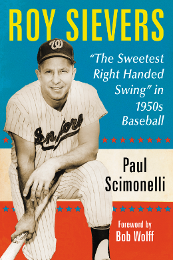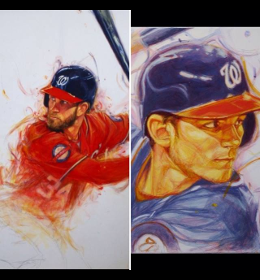One of the oddities of the 1891 season was the conflict that played out during the season between James “Deacon” McGuire and Wilfred “Kid” Carsey.
In August Kid Carsey’s father sends a letter to a local paper documenting what many people have long suspected. Mr. WA Carsey of this city, and father of the young Carsey, who is pitching for the Washington team writes: “The reason that James McGuire makes so many errors and cannot hit the ball when Carsey pitches is that they had a quarrel early in the season over who should make the signs and they are still enemies.”
Imagine if that took place today. Talk about bang zoom!
A rational person would ask how could it have come to such a bizarre situation. We will look at the two individuals first.
Deacon at 28 is a solid veteran catcher, one of the best defensive catchers in the game. He first played for the 1884 Toledo Association team. In 1885 he spent time with Detroit, appearing in thirty-four games. In 1886 he played for the Philadelphia League Club and would continue with them until 1888 when he was released. He would play briefly for Detroit and Cleveland. In 1890 he played with the minor league Rochester nine and jumped to Washington in February
In 1890, Kid Carsey played for Oakland in the California League, where he led the league in “box-work.” 1891 would be the young 18 year olds first in the majors. He pitched for the New York Mets a couple of years ago but only in exhibition games on their spring training in the south but was released. Carsey was born in New York, listed at just 5-07 168 pounds; he is considered a fair hitter, he pitches right handed and hit left handed. Carsey would later say about his pitching, “”They called me a fooler. I made a study of each batter’s weakness and knew just where to throw the ball. Sometimes I’d get ’em out and sometimes I wouldn’t.”
Soon one hand an established catcher and a young upstart pitcher. The season starts out with McGuire the primary catcher. During the spring Carsey moves from a dark horse to the ace of the staff, jumping past Frank Foreman and Jersey Bakley. Carsey is in the box on opening day with McGuire behind the bat.
Sam Trott has the tandem together and Carey and McGuire do well in April. Carsey is even awarded a small bonus, $50 for his efforts. In May, primarily through the efforts of Carsey the management signs, Pete Lohman, Carsey’s catcher from California. Lohman becomes Carsey’s personal catcher and McGuire will not work with Carey until early July.
The two reunite in early July, a tough loss for Carsey, but no mention is made of poor play on the part of McGuire. The two are reunited again in early August after Pete Lohman had been released. There had been talk about Lohman being black-listed for contract jumping. That may have been the factor although he batted under .200; Lohman later signs with Philadelphia but is too ill to play.
It should be noted that the team went through four managers during the season. Sam Trott was fired on 24 April. Pop Snyder lasted until 25 July. Then Dan Shannon took over until 28 September. So for most of this time, Snyder, a former catcher keeps Carsey and McGuire apart. Since McGuire was the best defensive catcher on the roster it might have made sense to team him with the young rookie.
With Shannon managing McGuire and Carsey play several games together, but still are not a battery. There are no indications of poor play on either player’s part. The murmurs of McGuire’s poor play in the field that were hinted during the season are mentioned in the press in early September. Cranks read, ““McGuire is not a good fielder.”
The two continue to play several games together in September, although McGuire continues to be a secondary, not primary catcher for Carsey. So how poorly did McGuire play? In 1891 McGuire’s fielding average behind the bat was .911. This is below the league average of .929. If you compare this to his career average of .938 to the league average of .942. McGuire evidently did play poorly but his appearances with Carsey were few and far between.
Certainly McGuire felt the rookie undercut him by refusing to have McGuire make the signs. Did Carsey’s role in the signing of Lohman play a part? Hard to say. Certainly Carsey was a hard luck pitcher who would pitch well but lose the game. Is it possible that other players picked up on McGuire’s lack of effort? But it should be noted that the conflict between the two was just another problem that plagued the 1891 team.
McGuire would go on to a long career in the majors. He finally hung up the mask and glove in 1912, he was 48. Carsey was 14 and 37! In 1891 with an ERA of 4.99. In 1892 he signed with the Phillies and won nineteen games. In the next four years he won twenty games twice and would finish with a record of 116 and 138. It should be noted that he returns to Washington in 1899, he is 1-2 with a 3.72 ERA.






